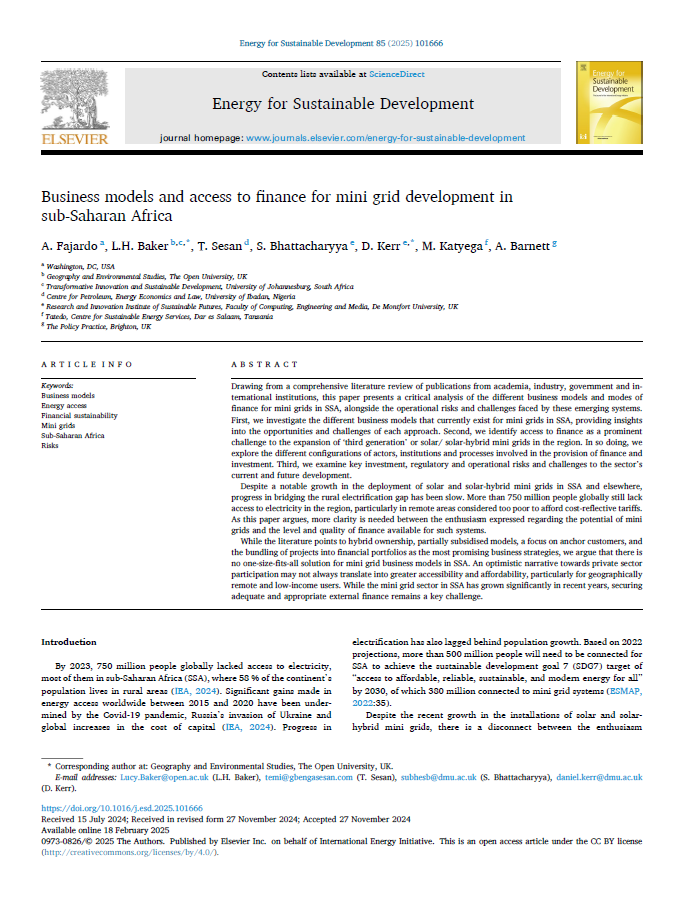Business models and access to finance for mini grid development in sub-Saharan Africa
 |
Modèles d'affaires et accès aux financements pour le développement de mini-réseaux en Afrique Sub-Saharienne
article Feb 2025 ; 13 pages
Aut. Adriana Fajardo & Lucy Baker & Andrew Barnett & Maneno Katyega & Daniel Kerr & Temilade Sesan & Subhes Bhattacharyya
Ed. TaTEDO - Dar es Salaam University of Ibadan - Ibadan University of Johannesburg - Johannesburg ; Isbn: 0973-0826
Téléchargeable sous format: PdF
Téléchargeable chez l'éditeur
Résumé:
Cet article scientifique propose une analyse critique des modèles d'affaires et modes de financements des mini-réseaux en Afrique Subsaharienne. Au delà de l'enthousiasme sur le potentiel de contribution des mini-réseaux à l'électrification rurale, il invite les lecteur·rice·s à se questionner sur les risques et les défis que posent la mise en place de ces systèmes, au regard de leurs moyens financiers. Abstract:
Drawing from a comprehensive literature review of publications from academia, industry, government and international institutions, this paper presents a critical analysis of the different business models and modes of finance for mini grids in SSA, alongside the operational risks and challenges faced by these emerging systems. First, we investigate the different business models that currently exist for mini grids in SSA, providing insights into the opportunities and challenges of each approach. Second, we identify access to finance as a prominent challenge to the expansion of ‘third generation’ or solar/ solar-hybrid mini grids in the region. In so doing, we explore the different configurations of actors, institutions and processes involved in the provision of finance and investment. Third, we examine key investment, regulatory and operational risks and challenges to the sector's current and future development. Despite a notable growth in the deployment of solar and solar-hybrid mini grids in SSA and elsewhere, progress in bridging the rural electrification gap has been slow. More than 750 million people globally still lack access to electricity in the region, particularly in remote areas considered too poor to afford cost-reflective tariffs. As this paper argues, more clarity is needed between the enthusiasm expressed regarding the potential of mini grids and the level and quality of finance available for such systems. While the literature points to hybrid ownership, partially subsidised models, a focus on anchor customers, and the bundling of projects into financial portfolios as the most promising business strategies, we argue that there is no one-size-fits-all solution for mini grid business models in SSA. An optimistic narrative towards private sector participation may not always translate into greater accessibility and affordability, particularly for geographically remote and low-income users. While the mini grid sector in SSA has grown significantly in recent years, securing adequate and appropriate external finance remains a key challenge.
Publics-Cibles:
Université , Acteurs de coopération , Socio-économiste , Economiste , Décideurs locaux ou nationaux
Mots clefs: |
accès à l’électricité (CI) (DT) (OP) (ope) , financement (CI) (DT) (OP) (ope) , mini-réseau micro-réseau (CI) (DT) (OP) (ope) |
Editeurs/Diffuseurs: |
|
TaTEDO
-
Centre for Sustainable Energy Services Organization - Dar es Salaam - Tanzanie |
University of Ibadan - Ibadan - Nigeria |
University of Johannesburg - Johannesburg - Afrique du Sud |
Elsevier - |
En cas de lien brisé, nous le mentionner à communication@pseau.org